

After the historic success of the Chandrayaan-3 mission soft landing on the Lunar south Pole, India is now part of an exclusive club along with the US, Russia and China: nations that have landed spacecraft on the Earth’s satellite.
Read more about the Indian Lunar mission:
But the Indian Space Agency (ISRO) is not resting in its laurels at all, but rather doubling down to cement its newfound reputation as a Space Superpower.
To begin with, the lander’s touchdown was only the first step in the lunar surface exploration mission.
Space.com reported:
“Since reaching the moon’s south pole, Chandrayaan-3 has been hard at work – having deployed a rover named Pragyan to explore the cratered surface, harnessed integrated cameras to send back videos of its environment and even started completing research objectives planned for a two-week stay on the orb.
On Saturday (Aug. 26), for instance, scientists with the Indian Space Research Organization presented a video on X (formerly known as Twitter) of Pragyan roaming around the mission’s landing point, which has been named the Shiv Shakti Point. In the video, the gold-colored moon explorer is seen on the other end of two delicate tracks it has created in lunar soil since exiting the lander that ushered it over there, named Vikram. The gingerly way Pragyan treads on a desolate gray world is almost charming.”
Chandrayaan-3 Mission:
?What’s new here?Pragyan rover roams around Shiv Shakti Point in pursuit of lunar secrets at the South Pole ?! pic.twitter.com/1g5gQsgrjM
— ISRO (@isro) August 26, 2023
“The purpose of this experiment, in essence, is to use a temperature probe as well as 10 individual temperature sensors to measure temperature profiles of lunar south pole soil. The goal, ISRO explains, is for ChaSTE to help scientists understand what the thermal behavior of the moon’s surface is like. And, as it appears, ChaSTE has already found some stuff out.”
But the moon is not the sum of India’s space ambitions. They are literally reaching for the stars: or, at least one. The star of our Solar system.
Reuters reported:
“India’s first space-based observatory to study the sun will be launched on Sept. 2, the country’s space agency said on Monday.
[…] The Aditya-L1, India’s first space-based solar probe, aims to study solar winds, which can cause disturbance on earth and are commonly seen as ‘auroras’.”
?PSLV-C57/??Aditya-L1 Mission:
The launch of Aditya-L1,
the first space-based Indian observatory to study the Sun ??, is scheduled for
??September 2, 2023, at
?11:50 Hrs. IST from Sriharikota.Citizens are invited to witness the launch from the Launch View Gallery at… pic.twitter.com/bjhM5mZNrx
— ISRO (@isro) August 28, 2023
“The craft, named after the Hindi word for the sun, will be launched from the country’s main spaceport in Sriharikota using India’s heavy-duty launch vehicle, the PSLV, which will travel about 1.5 million km (932,000 miles), the agency said.”
The travel time from launch to the final orbital destination will take about four months for Aditya-L1.
Source material can be found at this site.









